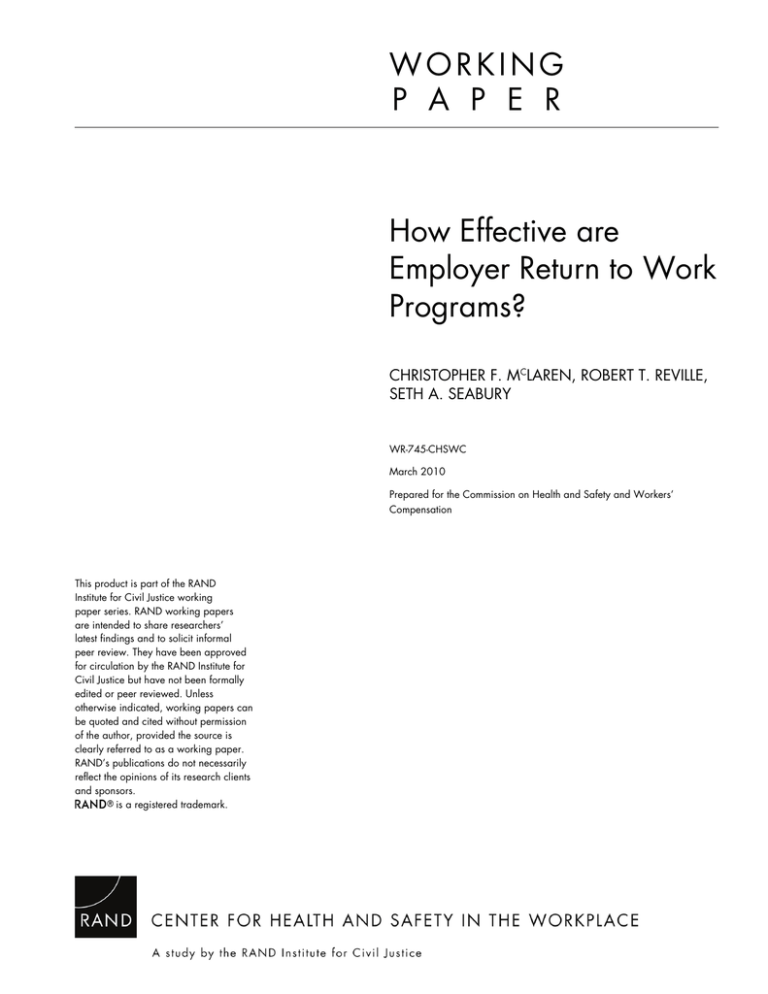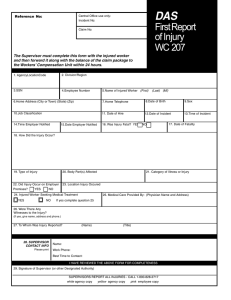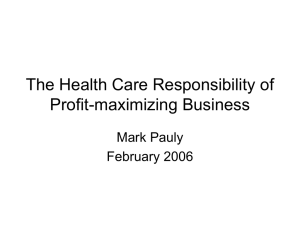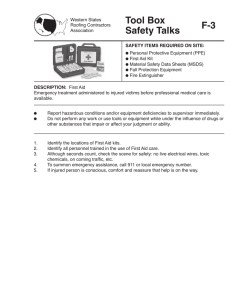W O R K I N G How Effective are
advertisement

WORKING P A P E R How Effective are Employer Return to Work Programs? CHRISTOPHER F. MCLAREN, ROBERT T. REVILLE, SETH A. SEABURY WR-745-CHSWC March 2010 Prepared for the Commission on Health and Safety and Workers’ Compensation This product is part of the RAND Institute for Civil Justice working paper series. RAND working papers are intended to share researchers’ latest findings and to solicit informal peer review. They have been approved for circulation by the RAND Institute for Civil Justice but have not been formally edited or peer reviewed. Unless otherwise indicated, working papers can be quoted and cited without permission of the author, provided the source is clearly referred to as a working paper. RAND’s publications do not necessarily reflect the opinions of its research clients and sponsors. is a registered trademark. Summary Introduction Workplace injuries and illnesses are extremely costly. In addition to the pain and suffering due to the injury itself, workers can experience severe and prolonged earnings losses. Accidents are costly to employers as well. Employers face the cost of reimbursing their injured workers, and also face indirect costs such as lost productivity. As part of their ongoing efforts to mitigate these costs, policymakers are continuously motivated to find new ways to reduce the duration of work-related absence and improve early return to work, a key metric for the impact of an injury on both workers and employers. Many policy initiatives that are intended to improve return to work for injured or disabled workers operate through the employers. For instance, some states offer subsidies to offset the costs to employers of hiring, retaining or accommodating disabled workers. These policies are adopted, however, with relatively little consensus among the scientific literature as to the effectiveness of these employer-based efforts. While, as we describe later, there have been numerous studies that have demonstrated these policies have some impact on reducing the duration of work absences, there is very little consensus as to whether the impact is large enough to justify the cost of intervening. This paper uses a unique data set that combines information from a firm-level survey of activities and policies designed to improve return to work matched to the post-injury employment outcomes for workers injured at these firms. The survey covered 40 large, self-insured employers in California and obtained detailed information about the formal programs and practices used to lower the duration of work-injury absences, including information such as the frequency of use of various modifications and accommodations. These survey data were matched to more than 17,000 workers injured from 1991-1995, and five years of post-injury employment data were collected. A key feature of our analysis is that some employers adopted a program during the period over which we S-1 observe workplace injuries, allowing us to employ firm fixed effects. This allows us to eliminate the firm heterogeneity that potentially confounds the analyses of many previous studies, making it more difficult to attribute causality to the programs themselves. Characterizing the Employer Use of Return to Work Programs Our data combine information on the return to work practices of a sample of large, private self-insured employers in California with the post-injury employment outcomes of those workers who experienced a work-related injury from 1991-1995 and filed a workers compensation claim. Our description of return to work practices comes from a 2000 survey conducted by RAND, in which they collected information from 40 firm about the most common features of the firm’s return to work program and disability management practices (if any). The survey asked employers to provide information about methods used to return injured employees to work, how often they are used, and the subjective importance of each method in relation to the overall effectiveness of the program (as of the time of the survey, 2000). Table S 1 summarizes the most common transitional work accommodation characteristics of the programs in our sample and the perceived level of importance as reported by each employer. The four primary characteristics we report are modified work tasks, providing a modified workstation or modified equipment, reduced time and work schedule changes, and providing a different job in either the same or a different department. Modified work is any temporary change in work tasks or functions, modified workstations and modified equipment allow injured workers to perform work functions while recovering from an injury, and reduced time/work schedules and providing a different job are examples of actions employers may take to facilitate the return of an injured worker to the workplace. Modified work tasks were the most common among employers in our sample, with 82% of the firms reporting that they use this method frequently or quite often. Roughly half of the sample reported providing a modified workstation or modified equipment frequently, or most of the time. S-2 Reduced time and work schedule changes were fairly common with 45% of the sample reporting use, and 32% of the firms reported providing a different job in either the same or a different department as used frequently or quite often. Table S 1. Perceived importance and frequency of use of leading methods for transitioning injured employees back to the workplace. Used Frequently or Quite Often Used Occasionally Used Rarely or Not at All Perceived Importance Level: Scale 1-5, 5=Very Important Modified work tasks 82% 14% 5% 4.68 Modified work station/equipment 50% 27% 18% 4.10 Method Reduced time/work 45% 27% 18% 3.86 schedule change Different job in same or different 32% 41% 23% 3.71 department Notes: Table reports the results from a survey of return to work and disability management practice of 40 large, self-insured firms in California. Programs are Associated with Lower Duration of Injury-Related Absences To estimate the impact of program use on return to work, we combine the survey information with data on the post-injury employment outcomes of workers at the surveyed firms. We link workers’ compensation claims information—was the claim temporary or permanent, how much was paid out in benefits, how many weeks were benefits received, etc.—collected directly from the employers to administrative data on wages. We use quarterly earnings data of all workers’ compensation claimants in our sample for up to 20 quarters after injury. As our primary measure of return to work, we estimate the number of weeks until an injured worker returns to work in two subsequent quarters after their temporary disability benefits have been exhausted.1 1 We also demonstrate that our main findings persist if we use an alternative measure, the number of weeks of temporary disability receipt. S-3 Figure S 1. Cumulative and Instantaneous Hazard Rates by Return to Work Program Participation Cumulative Instantaneous 1.00 0.25 0.20 0.75 0.15 0.50 0.10 0.25 0.05 0.00 0.00 0 10 20 30 40 50 Weeks No Program 0 10 20 30 40 50 Weeks Program in Place Figure S 1 illustrates the difference in return to work rates for employees who are injured with and without a program in place. The left panel in the figure reports the cumulative hazard rate for return to work, interpreted as the cumulative percent of workers who have returned by a given week. The figure shows that more than half of workers with or without a program return in the first 10 weeks. If a program is in place, however, there is a noticeable difference by 10 weeks, with workers in a program being more likely to return. This gap persists and widens over the entire first year after the date of injury. The right panel in the figure represents the instantaneous hazard rate for return to work, interpreted as the percent of the stock of workers that remain out of work who return in a given week. As with the cumulative hazard, the figure shows that workers injured with a program in place are more likely to return early on, and the difference persists over time. S-4 Table S 2. Estimated Change in the Median Weeks Before Return to Work with a Program in Place All Workers Positive PPD Median Number of Weeks (Mean in Parentheses) 1 2 3 4 Weeks Until Return to 9.0 8.9 39.7 35.5 work: (41.1) (40.8) (69.5) (65.2) No Program -3.8 -3.6 -18.8 -12.6 Difference (-15.7) (-15.1) (-25.9) (-17.6) Firm Fixed effects No Yes No Yes Notes: The table reports estimated median and mean weeks to return to work for workers not in a program, and the difference compared to workers who participated in a program. While instructive, this descriptive analysis fails to control for potentially confounding individual and firm characteristics. We employed a number of statistical models to estimate the program effect while controlling for these characteristics. Table S 2 summarizes our key results. The table reports the median number of weeks a hypothetical injured worker would be out of work with no program in place, and then reports the estimated change in weeks that would occur if a program were in place. We report medians as our primary estimates because the means are skewed by a relatively small number of workers with large estimates, but we also report means and mean differences in parentheses. Column 1 reports that the median number of weeks until return to sustained work is 9.0. Our estimates suggest that having a program in place reduces the median number of weeks that a worker is absent by 3.8, a difference of 42%. If we look at the mean difference, we see that the worker returns 15.7 weeks sooner on average, a 38% drop. We include different columns to indicate regressions that include either firm-level average characteristics or a firm-level dummy variable that controls for all time-invariant characteristics of the employer, and our findings are consistent across both specifications. Part of the skewness in the data is driven by the large differences in injury severity. Workers with permanent disability represent 40% of the sample, and the table reports that the median injury S-5 duration for a worker with permanent disability is 39.7 weeks (the mean is 69.5 weeks). The impact of the program is to reduce the median duration for those with a permanent disability by 18.8 weeks, or 47%. The effect is somewhat smaller if we include fixed effects and look at the mean difference, but this still represents a drop of 27%. This suggests that much of the program effect is driven by the large reduction in injury duration for the most severely injured workers. Program Use is Cost-Effective for Employers Our estimates indicate that the employer return to work programs reduce the duration of injury-related absences, but does that make their use profitable for firms? Sometimes the accommodations required can be quite costly, and ultimately we are interested in whether the benefits from improved return to work outweigh the costs to implement and maintain the programs. In Table S 3 we report some estimates of the cost-effectiveness of a program for employers in different scenarios. For our estimate of the program benefits to employers we use the dollar savings on TTD payments from shorter injury durations. Our different scenarios reflect different levels of weekly wages for employees, with higher weekly wages reflecting higher weekly benefits (and thus greater benefits of returning workers sooner). We compare these against different levels of average program costs per injured workers, using a range reflected by the survey data. Table S 3. Break-Even RTW Program Treatment Effects, Measured in Weeks to Sustained RTW Low: Weekly Wage $ 347 $ 500 1.4 Program Cost per Injured Worker $ 1,000 $ 1,500 $ 2,000 $ 2,500 2.9 4.3 5.8 7.2 $ 3,000 8.6 Medium: $ 438 1.1 2.3 3.4 4.6 5.7 6.8 High: 0.7 1.3 2.0 2.6 3.3 4.0 $ 757 The table reports the number of weeks of injury duration a program must reduce in order for the program to break-even. For example, in the low-benefit, low-cost scenario, the break-even estimate is equal to 1.4 weeks and any additional reductions in average durations generate a net benefit for the employer. Comparing our treatment effect estimates with the break-even numbers, the S-6 programs generate net benefits for all but the most expensive programs when wages (and thus weekly benefits) are high. With average wages, the programs are beneficial when the program cost per injured worker is below $1,500, and with low wages, the programs are beneficial when the program cost per injured worker is below $1,000.2 This table should not be taken to indicate that adopting a return to work program would be cost-effective for any employer. Ultimately, our findings suggest that return to work programs are highly effective when adopted at large, self-insured firms. It is by no means obvious that the programs would be as effective if adopted by a different set of firms. The costs per worker are likely to be higher for smaller firms if there are fixed costs of setting up a program (particularly likely for a program making a heavy emphasis on physical modifications). The effectiveness of programs may differ for different types of workers—smaller firms or firms with more homogenous job functions might find it more difficult to offer modified work. Future work should study how return to work programs can be implemented effectively at small firms. 2 Note that we use the use the median effects rather than the mean, because we feel that the mean effects better represent the gains the employer would observe in the highest number of cases. If we were to focus on the mean differences, the programs would be cost-effective in this example in all cases. S-7



